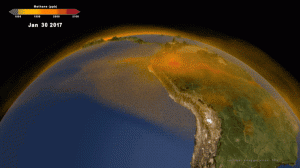
In South America, the Amazon River basin and its adjacent wetlands flood seasonally, creating an oxygen-deprived environment that is a significant source of methane. (Credit: NASA/Scientific Visualization Studio)
NASA's new 3D portrait of methane concentrations shows the world's second-largest contributor to greenhouse warming, the diversity of sources on the ground, and the behavior of the gas as it moves through the atmosphere. Combining multiple datasets from emissions inventories, including fossil fuel, agricultural, biomass burning and biofuels, and simulations of wetland sources into a high-resolution computer model, researchers now have an additional tool for understanding this complex gas and its role in Earth's carbon cycle, atmospheric composition and climate system.
Since the Industrial Revolution, methane concentrations in the atmosphere have more than doubled. After carbon dioxide, methane is the second-most-influential greenhouse gas, responsible for 20 to 30 percent of Earth's rising temperatures to date.
A single molecule of methane is more efficient at trapping heat than a molecule of carbon dioxide, but because the lifetime of methane in the atmosphere is shorter and carbon dioxide concentrations are much higher, carbon dioxide still remains the main contributor to climate change. Methane also has many more sources than carbon dioxide, these include the energy and agricultural sectors as well as natural sources from various types of wetlands and water bodies.

